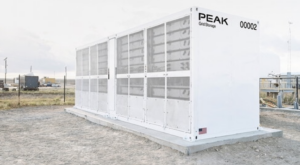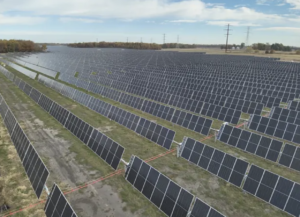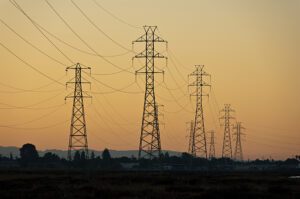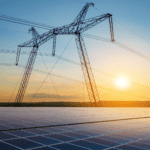
For decades, U.S. electricity demand was steady, allowing utilities to plan gradual growth and maintain the grid with modest upgrades. That era is over. The convergence of electric vehicles (EVs), data centers, technology advancements, and population growth and shifting is driving an unprecedented surge in electricity demand. According to the National Electrical Manufacturers Association (NEMA), electricity demand in the U.S. is projected to grow 50% by 2050, reflecting the greater imperative to modernize the transmission system.
This rising load is straining an aging grid. Many of the components that keep power flowing—wood and concrete poles, steel towers, conductors, cross-arms, and insulators—are well past their intended lifespans. Some transmission structures have been in service for more than 60 years, showing signs of rust, decay, and fatigue. The result is a system that is vulnerable to outages, bottlenecks, and costly delays in connecting new sources of clean energy.
Simultaneously, we are experiencing more and greater extreme weather events. Older transmission and distribution structures—and even more recent ones—were not designed for the meteorological loadings that our electric grid must handle today.
The U.S. grid was largely designed in the mid-20th century for a world where most electricity was generated by large, centralized fossil fuel plants and consumed in steady, predictable patterns. That grid was never built to handle today’s bidirectional power flows, distributed energy resources, or the sudden spikes in demand caused by high-performance computing. Modernizing the transmission grid is the only way to bring this mid-century network into the 21st century and prepare it for decades of growth.
The good news is that meeting growing electricity demand doesn’t require building new generation plants alone. Upgrading and optimizing existing transmission lines—the arteries that move electricity from generation sites to users—can increase capacity, improve efficiency, and strengthen grid reliability.
Infrastructure That Carries Renewable Energy
When most people think about the energy transition, they picture solar panels, wind turbines, or battery storage. Transmission lines rarely come to mind. Yet, these lines are the invisible highways of our power system. They carry electricity from remote wind farms and solar arrays to population centers, move power between regions, and provide redundancy when local generation falters.
This role is becoming even more critical as the grid shifts from centralized fossil fuel generation to distributed, renewable sources. Unlike coal or natural gas plants, which could be built near demand centers, wind and solar projects are often located hundreds of miles away. This means the electricity they produce must travel long distances to reach those who need it.
Without sufficient transmission capacity, clean energy projects are delayed, curtailed, or canceled altogether. The backlog of renewable projects waiting for grid interconnection is now one of the largest barriers to decarbonization.
Digital Tools Driving Transmission Line Upgrades
Modern digital design and modeling techniques are transforming how transmission lines are engineered and maintained. Sophisticated software now enables a single engineer to accomplish in months what once took a team of dozens years to complete, accelerating planning, reducing errors, and allowing upgrades to be completed quickly and efficiently.
The impact goes beyond efficiency. LiDAR (light detection and ranging) and high-resolution satellite imagery were already being used to model existing power corridors with unprecedented accuracy. After the Northeast blackout in 2003, which left 50 million people without power, utilities relying on digital tools were able to meet updated regulatory standards and strengthen system reliability. These technologies have been used to model more than 80% of high-voltage lines in the U.S. and Canada, improving both capacity and resilience.
By combining advanced software with detailed geospatial and engineering data, engineers can identify chokepoints, optimize upgrades, and prepare the grid to meet the growing demands of renewable energy, EVs, and data-driven infrastructure. Existing transmission and distribution lines can be modeled in a digital twin to quickly identify the areas that need to be strengthened to meet today’s weather events. These tools are helping the transmission and distribution system evolve from a reactive network into a modern, resilient backbone for America’s electrified future.
The Cost of Inaction
Neglecting the transmission system is not just an inconvenience, it is a risk to reliability and economic growth. The American Society of Civil Engineer’s (ASCE’s) recent infrastructure report card gave America’s energy grid a D-plus, citing aging equipment and lack of investment as key concerns.
Failing components can trigger cascading outages that leave millions without power. Today, the stakes are even higher. When the grid goes down, data centers go offline, commerce stops, and we can’t charge our cellphones or stream our favorite TV shows. That’s just a few examples of how deeply the economy and our everyday lives depend on a reliable power grid.
Utilities also face mounting pressure to connect large-scale data centers, which are power-hungry by design. By some estimates, supporting artificial intelligence (AI)-driven data centers alone will require an additional 35 GW of capacity by 2030, the equivalent of adding dozens of large power plants to the grid. Without significant transmission upgrades, this demand cannot be met.
Modernization Beats Greenfield Construction
One of the most effective ways to address these challenges is to upgrade and optimize existing transmission corridors. Replacing aging conductors with modern high-capacity wires, raising structures to meet newly required clearances, strengthening structures to meet updated safety and design codes, and re-rating lines can unlock significant capacity without waiting years for new rights-of-way.
This approach delivers several benefits, such as:
- Speed. Utilities can add capacity in months rather than the years it can take to permit and build new lines.
- Cost Savings. Upgrades are typically less expensive than building new generation or new transmission corridors.
- Reduced Environmental Impact. Reusing existing rights-of-way minimizes the need for new land acquisition and lowers permitting complexity.
- Improved Resilience. Modern materials and design standards help transmission and distribution systems withstand extreme weather and reduce maintenance costs.
To make this strategy work, though, utilities need accurate, high-resolution data on the current state of their assets. With aerial technology such as drones, engineers can create detailed models—digital twins—of existing systems, identify obstacles, and optimize upgrades before crews even step onsite. Modern digital modeling not only speeds planning and construction but also reduces risk, ensures compliance with updated standards, and unlocks additional capacity within existing transmission corridors.
Clearing the Permitting Bottleneck
Technical solutions alone are not enough. The permitting process for new transmission projects remains one of the most significant barriers to grid modernization. A single project crossing federal land can require approvals from dozens of agencies, leading to delays of 10 years or more.
Regulatory reform is essential. Streamlining reviews, setting clear timelines, and coordinating between agencies could dramatically accelerate critical projects. Policymakers and regulators have an opportunity to treat transmission upgrades with the same urgency as other national infrastructure priorities, recognizing their role in economic security and decarbonization.
Building the Workforce for the Grid of the Future
Upgrading the grid is also a workforce challenge. The transmission sector is facing a shortage of skilled engineers, line workers, and planners at the same time demand for their expertise is rising. Investment in workforce development will be just as important as investment in steel and concrete. Partnerships with universities, training programs for new technicians, and mentorship initiatives can ensure the next generation of engineers is prepared to tackle the complexity of grid modernization.
Technology can play a role here, too. Digital design and simulation tools allow junior engineers to experiment safely, learn from modeled scenarios, and build confidence before they work on live systems. A stronger, more skilled workforce will be essential to deliver projects on time and maintain reliability as the grid grows more complex.
Where We Go from Here
The U.S. is at an inflection point. The electricity grid we rely on every day is under strain from forces it was never designed to handle. At the same time, we have the tools, technology, and expertise to strengthen it if we act decisively.
Modernizing the transmission system is not just an engineering challenge; it is an economic and societal imperative. Investment in transmission delivers outsized returns in reliability, resiliency, and access to clean energy.
Utilities, regulators, and policymakers must work together to prioritize transmission upgrades, adopt and enforce modern design standards, and streamline permitting processes. By doing so, we can build a grid that is not only capable of meeting today’s demand but also ready for the reliable electrified future, supporting data centers, EVs, and technologies that have yet to be invented.
The grid is the backbone of modern life. Strengthening it now is the surest way to power the next chapter of American progress.
—Otto Lynch is vice president, head of Power Line Systems, with Bentley Systems.









